First Seattle Sand Mandala Made by Tibetan Nuns
Written by: Cristina Sarnelli
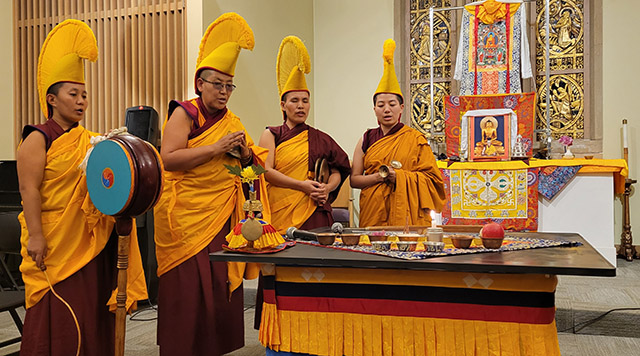
The nuns chant and play instruments to consecrate the site. Left to right: Sonam Dolma, Geshema Yeshi Sangmo, Chung Dolma, Sherab Dolma.
Photos by: Cristina Sarnelli
Four visiting Tibetan Buddhist nuns created a sand mandala in Seattle this fall, the first time female monastics have done so in this city.
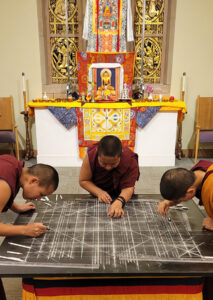
The four, from Jangchub Choeling Nunnery in India, visited Seattle Sept. 30 to Oct. 5 as part of their first-ever U.S. tour. The fact that they accomplished the tour and sand mandala ceremony without help from male monastics, marks a significant advancement for monastic women in Tibetan tradition.
The Jangchub Jamste Tour was led by Geshema Yeshi Sangmo, who was accompanied by nuns Sonam Dolma, Chung Dolma, and Sherab Dolma. The tour included 21 stops across the U.S., from March 2024 to January 2025. During each stop the nuns created a sand mandala, while offering meditation, prayer services, and Buddhist teachings.
The nuns assembled the sand mandala over six days, in a small chapel at the University Congregational United Church of Christ, just north of the University of Washington campus. The event was organized in partnership with Jordan Van Voast, president of the Dharma Friendship Foundation, and the Rev. Michael Ellick, one of two ministers at University United Church of Christ.
Sand mandala ceremonies have traditionally been led by male monastics, usually guided by a geshe, a monk with the equivalent of a doctorate degree. It was only in 2012 that women were first allowed to pursue geshema degrees, the female equivalent of geshe degrees, with the support of the Dalai Lama and others in Tibetan leadership. The degree is awarded after a minimum of 17 years studying the five main Buddhist texts of the Gelugpa school, and after passing four years of arduous examinations.
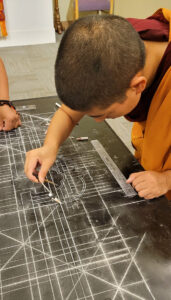
Sangmo, one of 20 nuns in the first-ever class of geshemas, represents the shifting landscape of traditional monastic roles in Tibetan Buddhism. Her leadership of the tour is a powerful testament to the evolving role of women in Buddhism, a role she believes is rooted in extending love and compassion throughout the world.
“It is really important for us, the nuns, to be in the presence of this Buddhist community and even in the world,” Sangmo said, through translator Lobsang Chime, coordinator of the tour. “His Holiness, [the Dalai Lama] always tells us how important the role women should play is. Even in the family, if the family head is a woman, it runs more smoothly. Women’s love, a mother’s love and compassion toward her children, is really different. They have more connection.”
Sangmo’s emphasis on compassion reflects the tour’s broader mission: to extend the blessings of the teachings and the sand mandala to as many beings as possible, with hopes of easing their suffering. Seattle’s selection as a tour stop provided a unique opportunity for locals to witness this sacred practice up close.
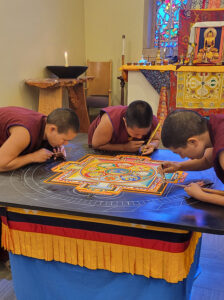
The mandala ceremony began with the consecration of the site. To bless the site and sands before building the mandala, the nuns chanted in Tibetan. As their harmonies dipped and swelled together, they accompanied the blessing by ringing bells, clashing cymbals, and beating a drum.
At the center of the room was a square platform with a black chalkboard surface, on which were positioned several gold and silver bowls filled with brightly colored sands. A variety of rulers, fluted funnels, and drawing compasses accompanied the bowls. At the back of the room was a Buddha shrine, its image draped in fabrics rich in red, yellow, orange and blue. Incense filled the air with a woody scent.
At the close of the blessing, the platform was cleared so the black surface was laid bare. The nuns stretched a string caked in white chalk across the width of the surface. Sangmo gently tugged the string back like a rubber band so that when she let go, it gently tapped the black surface, leaving behind the first gridline of the mandala’s design. Then Sonam Dolma, Chung Dolma, and Sherab Dolma moved around the table, repeatedly repositioning and snapping the chalked string against the surface to create the full grid, within which they would draw the intricate mandala.
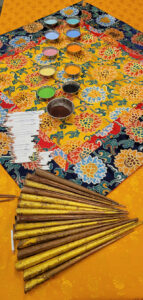
Once the gridlines were created, each nun used drawing compasses, ranging in size from those used in a typical geometry class to one that was nearly as large as an easel, to create the curved shapes of the mandala. The rest of the design was completed by hand with white pencils.
For the next five days the nuns filled in the outline using chak-purs, narrow metal funnels featuring transverse ridges along the length of each. When a nun rubbed a rod down the ridges, it created vibrations in the funnel, through which the nuns carefully controlled the flow of sand granules into the mandala.
Working from the center outward, the nuns created a kaleidoscope of spiritual figures, animals, geometric shapes, and flowers. In addition to being visually striking because of the variety of vivid colors involved, the design had height and texture akin to a 3D topographic map.
The final design paid homage to Akshobhya Buddha, one of the five wisdom buddhas in Tibetan and Mahayana tradition. Akshobhya, known as the “immovable one,” represents the undisturbed, patient nature of enlightenment.
Community members were invited to view the completed mandala briefly, before the dissolution ceremony. Sangmo hoped that through viewing the mandala, people would experience calm amidst life’s turmoil.
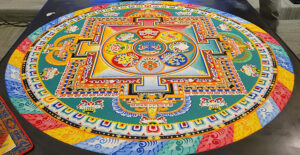
“We want people to get some happiness from it — joy. We want viewers to feel calm after viewing the mandala…The person doesn’t have to be [a] believer of Buddhism. It can be anyone,” Sangmo said. “After knowing a little bit about mandalas, people might start analyzing all those things that are suffering. We hope that by creating the mandala, not only will we give them our joy, but that it can be another tool to eliminate all those afflictions that we have within ourselves.”
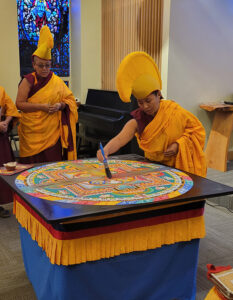
The dissolution is a unique aspect of sand mandala practice, in which the mandala is wiped away after creation.
Before dissolving the mandala, the nuns offered the same chant that opened its creation. Sangmo then took a rolling tool to cut lines through the mandala, and Sonam Dolma used a large paintbrush to sweep the design into a mound of sand at the center. The design transformed from an elaborate image into a hurricane spiral of muddled colors, symbolizing that all things, no matter how beautifully constructed and amazing to behold, are impermanent.
For the final part of the ceremony, the nuns gathered all the sand into an urn and made their way to a dock over Seattle’s Portage Bay. After performing a final chant Sangmo poured the sand into the water, believing it would carry blessings to countless beings through the flow of the bay and beyond, through evaporation and rainfall.
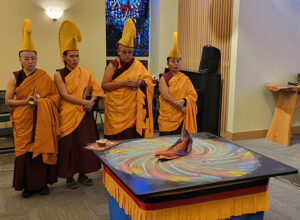
For many in attendance, the opportunity to witness nuns leading such a sacred ritual was powerfully moving.
“I’ve been on the periphery of Tibetan Buddhism for many years, and I saw the event advertised and decided to attend,” said Ivey Lufkin, who joined the closing ceremony. “It was very emotional and touching, because I’ve never seen Buddhist nuns in person.”
For others the milestone event held even deeper significance, symbolizing a breakthrough in gender roles within Tibetan Buddhism. Watching female monastics lead a spiritual tradition traditionally overseen by men, highlighted women’s progress toward equality with men in monastic settings.
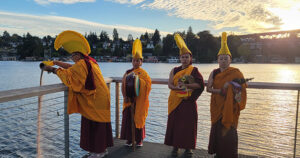
“As a woman and a feminist, having female leadership of this type of ceremony is really beautiful,” said Devon Klein, who attended the opening ceremony. “Although the Buddha taught that all humans have equal access to enlightenment, his teachings were interpreted within societies that have patriarchy, therefore nuns have a lot to contend with. To be part of celebrating them having this type of access to travel, to sharing the dhamma, and sharing their cultural heritage, was just beautiful.”
While the Jangchub Jamste Tour, like the sand mandala, came to an end, the impact of Jangchub Choeling’s female monastics continues — initiating a ripple of transformation that will continue to expand and empower the role of women in Buddhism.
Cristina Sarnelli is a Buddhist practitioner and volunteer sangha coordinator at Clear Mountain Monastery in Seattle, a community following the Theravada Thai forest tradition under the guidance of Ajahn Kovilo and Ajahn Nisabho. She began her career as an audio journalist, and has since transitioned into the world of qualitative interviewing and analysis. Sarnelli ascribes to the feminist hope that women will one day be granted full equality in all realms.
